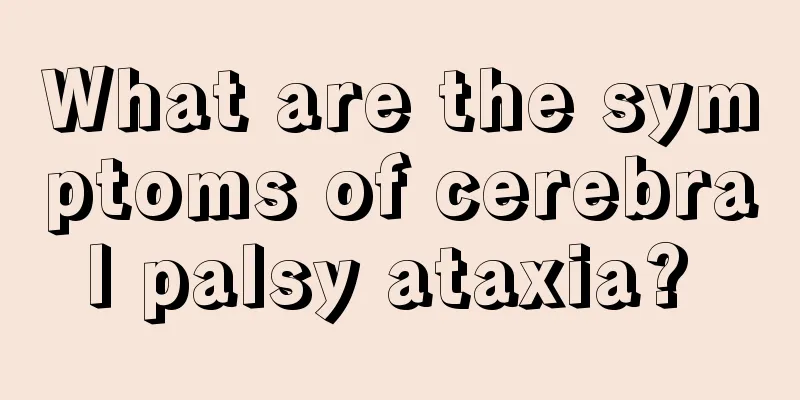What are the symptoms of cerebral palsy ataxia?

|
Cerebral palsy ataxia is a common disease among many cerebellar lesions. Most of them occur in patients with brain damage, meningitis or cerebellar tumors. Careful judgment methods are required to choose appropriate and standardized methods for treatment. Patients will mainly show symptoms of inability to control themselves, movement disorders, and frequent drooling. More serious symptoms may lead to balance dysfunction, inability to stand up and walk normally, causing many inconveniences in movement. The main lesions of the ataxia type are in the cerebellum and its pathways, and are often seen in the sequelae of diseases such as hydrocephalus, craniocerebral trauma, encephalitis or cerebellar tumors. Simple ataxia is rare. Cerebral palsy with ataxia as the main feature accounts for about 5% of the total. The disorder of movement sense and balance sense causes uncoordinated movements, which are manifested as low muscle contraction ability, slow muscle contraction speed, low orientation and distance determination ability. Moreover, muscle contraction is inaccurate, resulting in inability to move correctly. The walking step is wide, the foot's force point is often placed on the heel, the lumbar spine is often excessively bent forward, the trunk and limbs are not coordinated, swaying left and right or leaning to one side, unable to move in a straight line, staggering, as if drunk. This gait is not much different with eyes open and closed, the hand's directional ability is poor, and the finger-to-nose test and the heel-shin-knee test are difficult to complete. The voice trembles, the facial expression is dull, and the facial muscles are stiff. As the child grows older, he or she may eventually learn to limit his or her movements and become somewhat more self-controlled, although his or her movements will appear stiff and mechanical. The free-motion system is completed with the participation of the cerebral cortex, cerebellum, vestibular system, and deep sensory system. Depending on the location of the lesion, ataxia can be divided into cerebral ataxia, cerebellar ataxia, vestibular ataxia and sensory ataxia. Main manifestations 1. The motor development is significantly delayed compared with children of the same age, with clumsy and uncoordinated movements, and head and trunk adjustment disorders. The child cannot sit at around 1 year old, and even if he can sit, he is not stable. It is only possible to sit steadily when both lower limbs are flexed and abducted and the support surface is expanded. The children start standing late, usually 2-3 years old or later. They cannot stand steadily and are prone to falling. They also have fine motor disorder in their fingers and are not flexible in their movements. 2. Intentional tremor and nystagmus make it very difficult to track and grasp objects with a purpose. 3. The child often opens his mouth, drools, speaks slowly and unclearly, and has language disorders. 4. The child has low muscle tone but normal tendon reflexes. 5. Balance dysfunction. When standing, the center of gravity is on the heel. In order to maintain balance, the children often raise their toes, increase the distance between their feet to expand the support area, and bend forward to compensate for the backward shift of the center of gravity. |
<<: Why is the transaminase normal but the bilirubin high?
>>: Why is sugar-free chewing gum sweet?
Recommend
Several yoga moves that are beneficial for cervical spondylosis
Yoga has many benefits, especially for women. Man...
How to identify whether jade is real or fake
Jade has been loved by people since ancient times...
What to do if you have blood-heat type urticaria
Blood-heat urticaria, many people are not particu...
What is rosin
When it comes to what rosin is, I believe many pe...
Should I squeeze the abscess in my ear hole?
Girls love beauty and prettiness. Although earrin...
What should I do if I have been catching a cold recently?
Summer is here and the weather is getting hotter ...
The benefits of using Chinese medicine after prostate cancer surgery
Many people do not believe that kidney cancer can...
How to prevent lymphoma recurrence
There are many patients with lymphoma. This disea...
What causes plum blossom rash
Pityriasis rosea and pityriasis rosacea are two d...
How to treat eye arteriosclerosis?
Of course, the treatment of ocular arterioscleros...
Can enteritis cause colon cancer?
Will enteritis cause colorectal cancer? Enteritis...
How to effectively treat negative blocking antibodies
If the blocking antibody is negative, the most co...
Office workers beware: Be careful of "overwork obesity" if you sit for a long time
The extra pressure in modern society has not only...
How to reduce swelling of bruised lips the fastest
Lips are a relatively fragile part of the body. I...
How to improve skin redness? How to improve red blood streaks
We all know that there are several types of skin,...









